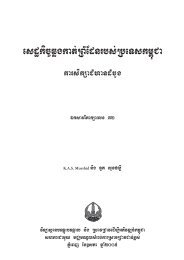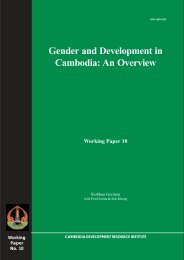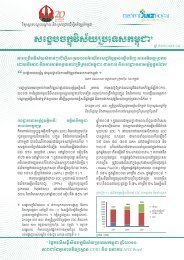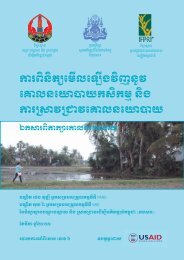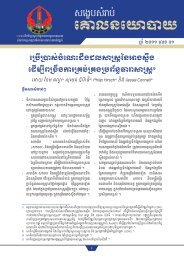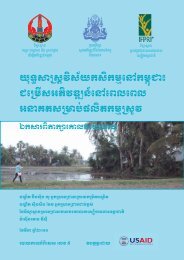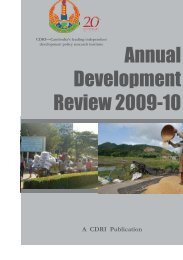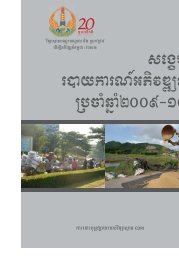62) decentralised governance of irrigation water in cambodia - CDRI
62) decentralised governance of irrigation water in cambodia - CDRI
62) decentralised governance of irrigation water in cambodia - CDRI
Create successful ePaper yourself
Turn your PDF publications into a flip-book with our unique Google optimized e-Paper software.
aware <strong>of</strong>: 1) the need for <strong>irrigation</strong> <strong>water</strong> dur<strong>in</strong>g the dry spell <strong>in</strong> the wet season; 2) when and<br />
where <strong>water</strong> scarcity may occur <strong>in</strong> the dry season; and 3) the possibility <strong>of</strong> <strong>water</strong> shortage at<br />
the beg<strong>in</strong>n<strong>in</strong>g and the end <strong>of</strong> the wet season. The PDOWRAM <strong>of</strong>ficer po<strong>in</strong>ted out that this<br />
awareness must be accompanied by the capacity to plan, allocate or store <strong>water</strong> as required on<br />
their own (i.e. ideally without PDOWRAM’s guidance). Moreover, FWUC committees must<br />
be able to ensure that their members and farmers 1) understand these issues well, and 2) get<br />
proper agricultural knowledge.<br />
Two scales <strong>of</strong> local coord<strong>in</strong>ation issues or conflicts were found to occur across the three<br />
case-study schemes: 1) between neighbour<strong>in</strong>g farmers, and 2) between farmers from upper and<br />
lower regions <strong>of</strong> the same scheme. At the local scale, coord<strong>in</strong>ation and collaboration between<br />
farmers was <strong>of</strong>ten <strong>in</strong>hibited by the fact that farmers who share adjacent rice paddies <strong>of</strong>ten<br />
come from different villages that are kilometres apart. It was observed and reported that this<br />
situation makes it difficult for farmers to develop camaraderie and mutual trust and to amicably<br />
resolve issues regard<strong>in</strong>g their rice paddies. In the DAP and Stung Ch<strong>in</strong>it schemes, conflicts<br />
regard<strong>in</strong>g broken levees between neighbour<strong>in</strong>g fields <strong>of</strong>ten occur where farmers have allowed<br />
their buffalo to trample levees to transport rice or let <strong>water</strong> <strong>in</strong>to their own rice fields, and more<br />
<strong>of</strong>ten than not left the levees unrepaired 20 . Understandably, such action leads to conflict as the<br />
victims would lose their <strong>water</strong> and with it their <strong>in</strong>vestment <strong>in</strong> fertiliser/pesticide and the results<br />
<strong>of</strong> their hard work, ultimately result<strong>in</strong>g <strong>in</strong> reduced rice yield and livelihood.<br />
The Kampong Thom PDAFF noted that at the time <strong>of</strong> study, a number <strong>of</strong> farmers <strong>in</strong><br />
Stung Ch<strong>in</strong>it scheme were not tak<strong>in</strong>g good enough care <strong>of</strong> their rice crops. After plant<strong>in</strong>g rice<br />
(broadcast<strong>in</strong>g seeds) they would abandon leave their field to f<strong>in</strong>d work elsewhere until harvest<br />
time. It was <strong>of</strong>ten the case that farmers <strong>in</strong> neighbour<strong>in</strong>g fields would cut the levees <strong>of</strong> these<br />
absent farmers’ paddies to take <strong>water</strong> to their own rice fields. When <strong>in</strong>terviewed, one farmer<br />
said:<br />
...I used to chop/cut down the dam/levee and steal <strong>water</strong> from a Sre Ta Kaor villager.<br />
That <strong>water</strong> can be used for some rice fields. We do it because Sre Ta Kaor villagers can<br />
receive more <strong>water</strong> from the dra<strong>in</strong>age. (Sangkrous Villager, Stung Ch<strong>in</strong>it Scheme, 2010)<br />
The situation <strong>in</strong> Rolous demonstrates the coord<strong>in</strong>ation struggles and conflicts that arise<br />
over <strong>water</strong> allocation at sub-scheme level,between upstream and downstream <strong>water</strong> users with<br />
differ<strong>in</strong>g <strong>water</strong> needs. The environmental issues are annual flood<strong>in</strong>g <strong>of</strong> Rolous and Sroyov<br />
areas, which began to occur after the renovation <strong>of</strong> the Rolous <strong>irrigation</strong> dam, and poor <strong>water</strong><br />
allocation at the scale <strong>of</strong> the command area. These have been the primary causes <strong>of</strong> conflict<br />
between farmers. There are essentially four groups <strong>of</strong> <strong>water</strong> users <strong>in</strong> the Rolous scheme which<br />
require <strong>water</strong> at different times <strong>of</strong> the year and <strong>in</strong> different quantities. The first group consists<br />
<strong>of</strong> O Kunthor farmers liv<strong>in</strong>g to the east <strong>of</strong> the ma<strong>in</strong>, privately owned, canal near Boeung<br />
Lies; the second comprises farmers liv<strong>in</strong>g and farm<strong>in</strong>g near Rolous village <strong>in</strong> the south-west;<br />
the third consists <strong>of</strong> the private fish<strong>in</strong>g lot owners operat<strong>in</strong>g <strong>in</strong> Prek Sbov stream; and the<br />
fourth <strong>in</strong>cludes those farmers with fields <strong>in</strong> the central to north-east region <strong>of</strong> the scheme. The<br />
<strong>irrigation</strong> <strong>in</strong>frastructure does not meet the quantity,or the temporal demands <strong>of</strong> these four <strong>water</strong><br />
user groups. Every year, the FWUC committee with the support <strong>of</strong> the CC and PDOWRAM,<br />
has tried to lobby the FWUC farmers to discuss and negotiate <strong>water</strong> allocation strategies for the<br />
wet-season. However, the actual beneficial outcomes <strong>of</strong> these efforts had been few, especially<br />
for the farmers <strong>in</strong> the Rolous village area whose problems cannot be solved without fundamental<br />
re-development <strong>of</strong> the scheme’s <strong>in</strong>frastructure.<br />
20 Interview with villagers <strong>in</strong> Tbeng Village, 2010.<br />
<strong>CDRI</strong> Work<strong>in</strong>g Paper Series No. <strong>62</strong><br />
27



